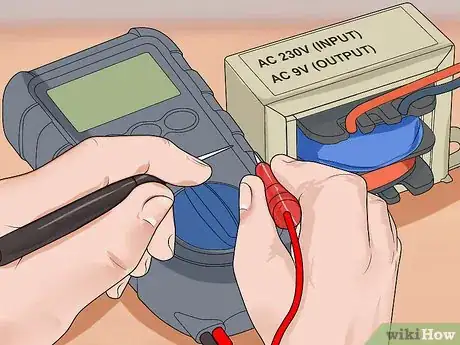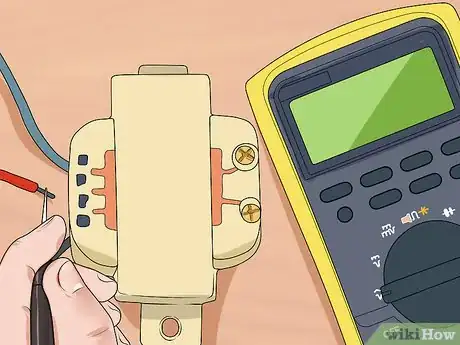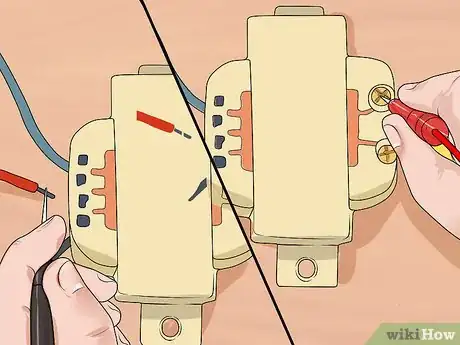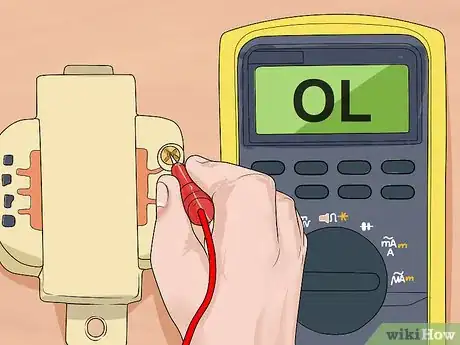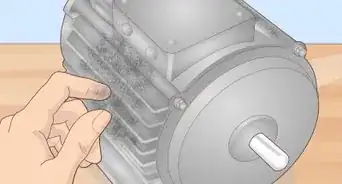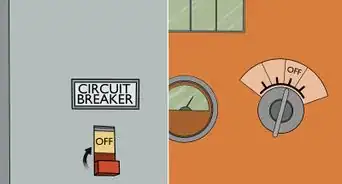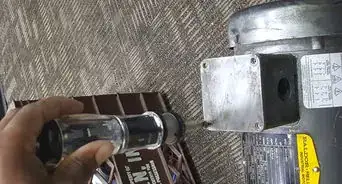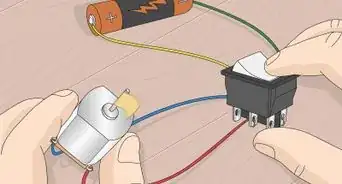This article was co-authored by Jesse Kuhlman. Jesse Kuhlman is a Master Electrician and the Owner of Kuhlman Electrician Services based in Massachusetts. Jesse specializes in all aspects of home/residential wiring, troubleshooting, generator installation, and WiFi thermostats. Jesse is also the author of four eBooks on home wiring including "Residential Electrical Troubleshooting" which covers basic electrical troubleshooting in residential homes.
wikiHow marks an article as reader-approved once it receives enough positive feedback. In this case, 82% of readers who voted found the article helpful, earning it our reader-approved status.
This article has been viewed 642,436 times.
Transformers are an electrical component that transmit electrical energy between at least two circuits. Transformers regulate the voltage in circuits, but in some cases these can go bad and cause a circuit to not work. You'll need to identify key information about your transformer, like whether it's suffered visible damage and what its inputs and outputs are. After that, it should be relatively simple to test the transformer with a digital multimeter (DMM). Should you continue having problems with the transformer, you'll need to troubleshoot it.
Steps
Identifying Key Transformer Information
-
1Inspect the transformer visually. Overheating, which causes the internal wiring of the transformer to run at elevated temperatures, is a common cause of transformer failure. This often causes a physical deforming of the transformer or the area surrounding it.
- If the transformer exterior is bulged or shows what appear to be burn marks, don't test the transformer. Instead, replace it.
-
2Determine the wiring of the transformer. The wiring should be clearly labeled on the transformer. However, it is always best to obtain a schematic of the circuit containing the transformer to determine how it is connected.
- The schematic for the circuit will be available in the product information or on the website of the circuit manufacturer.[1]
Advertisement -
3Identify the transformer inputs and outputs. The first electrical circuit will be connected to the primary of the transformer. This is its electrical input. The second circuit receiving power from the transformer is connected to the transformer secondary, or the output.[2]
- The voltage being supplied to the primary should be labeled both on the transformer and the schematic.
- The voltage being generated by the secondary should be labeled in the same fashion as the primary.
-
4Determine the output filtering. It is common to attach capacitors and diodes to the transformer secondary to convert the AC power from the output to DC power. This information will not be available on the transformer label.[3]
- Generally, you can find the transformer conversion and output filtering information on the schematic.
- Look for whether the transformer is AC or DC wherever the voltage is listed on the label.[4]
Testing a Transformer with a DMM
-
1Prepare to measure the circuit voltages. Turn off the power to the circuit. Remove covers and panels as necessary to gain access to the circuits that contain the transformer. Acquire a digital multimeter (DMM) to take the voltage readings. DMMs are available at electrical supply stores, hardware stores, and hobby shops.[5]
- Generally, you'll need to attach the leads of your DMM to the input lines to verify that the primary of the transformer is not shorted. The same process will be used to check the transformer secondary.
-
2Confirm the proper input to the transformer. Apply power to the circuitry. Use the DMM in AC mode to measure the transformer primary. If the measurement is less than 80 percent of the expected voltage, the fault could lie in either the transformer or the circuitry providing the primary with power. In that case:
- Separate the transformer from the input circuit. Test the input with your DMM. If the input power climbs to the expected value, the primary of the transformer is bad.
- If the input power does not climb to the expected value, then the problem lies not with the transformer, but with the input circuitry.[6]
- The input and output on the transformer may be labeled with "input" and "output," or the input might be a black and white pigtail.[7]
- If the transformer has terminals, the input will usually be L, which stands for "line," or hot power, and N, which stands for neutral, or the neutral power going into that wire. The output will be the low voltage side.[8]
-
3Measure the secondary output of the transformer. If there is no filtering or shaping being performed by the secondary circuitry, use the AC mode of the DMM to read its output. If there is, use the DC scale of the DMM.
- If the expected voltage is not present on the secondary, either the transformer or a filtering or shaping component is bad. Test the filtering and shaping components separately.
- If the testing of the filtering and shaping components show no problems, then the transformer is bad.[9]
Troubleshooting Your Transformer
-
1Understand the root of the problem. Transformer failure is usually a symptom of a different kind of failure somewhere in the electrical circuit. Transformers generally have long lives, and rarely burn out by themselves.[10]
-
2Observe replaced transformers. If the problem causing your transformer to short out is coming from elsewhere in your circuit, it's likely the transformer will burn out again. After you've replaced the transformer, observe it to make sure this does not happen. If it does, you'll need to perform additional tests.
- An overloaded transformer will often make snapping and crackling noises. If you hear sounds like these, cut power to the transformer to prevent burnout.[11]
-
3Verify the condition of external fuses, if necessary. If your transformer has an internal fuse, you may not have fuses in the line leading up to the transformer. Otherwise, there should be fuses in the power supply line to the transformer. Check to make sure these are in good condition and replace any that aren't working properly.
- Blackness, melting, and deforming in fuses are good indications that the fuse has been damaged. Simple remove and replace these.
- In some cases, it might be hard to tell if a fuse is in good condition. Attach your DMM to the fuse with one lead on each fuse end. If current runs through the fuse, it's good.[12]
-
4Check for overdraw on your secondary. In some cases, the secondary of your transformer may be drawing too much current, causing it to short out. If you have a multi-tap transformer and you receive the reading "OL" from the secondary, it's likely the secondary is shorted.
- Test this by hooking up the secondary to its circuit and using your DMM to test the secondary lines. If the reading is above the amperage rating for the transformer, the circuit is drawing too much power.
- Many common transformers have 3 amp fuses. The amperage rating for your transformer fuse may be labeled on the transformer, but will also be available in the circuit schematic.[13]
-
5Remove inputs and outputs to determine the source of the failure. For linear fuses, you'll only have one input and output. In this case, your trouble is either coming from the input circuit or the output circuit. For more complex fuses, remove inputs and outputs to the transformer one by one to determine what component of the entire circuit is causing the short.[14]
Expert Q&A
-
QuestionWhere should I look to find the input and output of a transformer?
 Jesse KuhlmanJesse Kuhlman is a Master Electrician and the Owner of Kuhlman Electrician Services based in Massachusetts. Jesse specializes in all aspects of home/residential wiring, troubleshooting, generator installation, and WiFi thermostats. Jesse is also the author of four eBooks on home wiring including "Residential Electrical Troubleshooting" which covers basic electrical troubleshooting in residential homes.
Jesse KuhlmanJesse Kuhlman is a Master Electrician and the Owner of Kuhlman Electrician Services based in Massachusetts. Jesse specializes in all aspects of home/residential wiring, troubleshooting, generator installation, and WiFi thermostats. Jesse is also the author of four eBooks on home wiring including "Residential Electrical Troubleshooting" which covers basic electrical troubleshooting in residential homes.
Master Electrician The input and output on a transformer is almost always going to be labeled—usually simply with "input" and "output."
The input and output on a transformer is almost always going to be labeled—usually simply with "input" and "output."
Warnings
- While the circuits are exposed and energized for testing, accidental contact with circuit power could cause shock or injury. Touch the circuit only with the probes of the DMM.⧼thumbs_response⧽
Things You'll Need
- Schematic of the circuit
- Digital Multimeter (DMM)
References
- ↑ http://www.electronicrepairguide.com/testing-transformer.html
- ↑ http://www.electronicrepairguide.com/testing-transformer.html
- ↑ http://www.electronicrepairguide.com/testing-transformer.html
- ↑ Jesse Kuhlman. Master Electrician. Expert Interview. 29 April 2020.
- ↑ http://www.electronicrepairguide.com/testing-transformer.html
- ↑ http://www.electronicrepairguide.com/testing-transformer.html
- ↑ Jesse Kuhlman. Master Electrician. Expert Interview. 29 April 2020.
- ↑ Jesse Kuhlman. Master Electrician. Expert Interview. 29 April 2020.
- ↑ http://www.electronicrepairguide.com/testing-transformer.html
About This Article
To test a transformer with a digital multimeter (DMM), first turn off power to the circuit. Next, attach the leads of your DMM to the input lines. Use the DMM in AC mode to measure the transformer primary. If the measurement is less than 80% of the expected voltage, your problem could be with the transformer or the circuitry providing the primary power. To measure the secondary output, use the AC mode if there’s no filtering or shaping. Otherwise, use the DC scale to determine what the issue is. To learn how to troubleshoot your transformer, keep reading!





